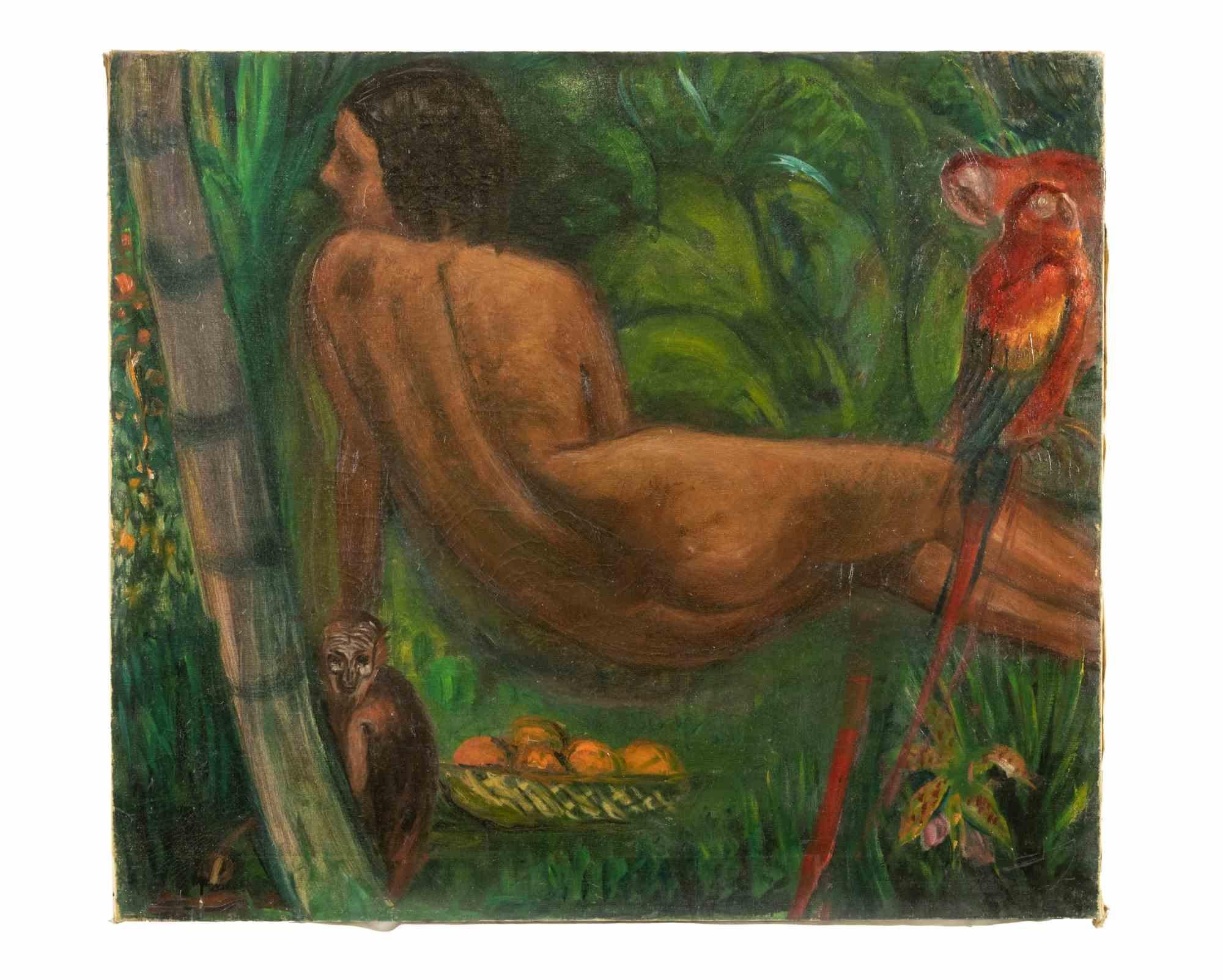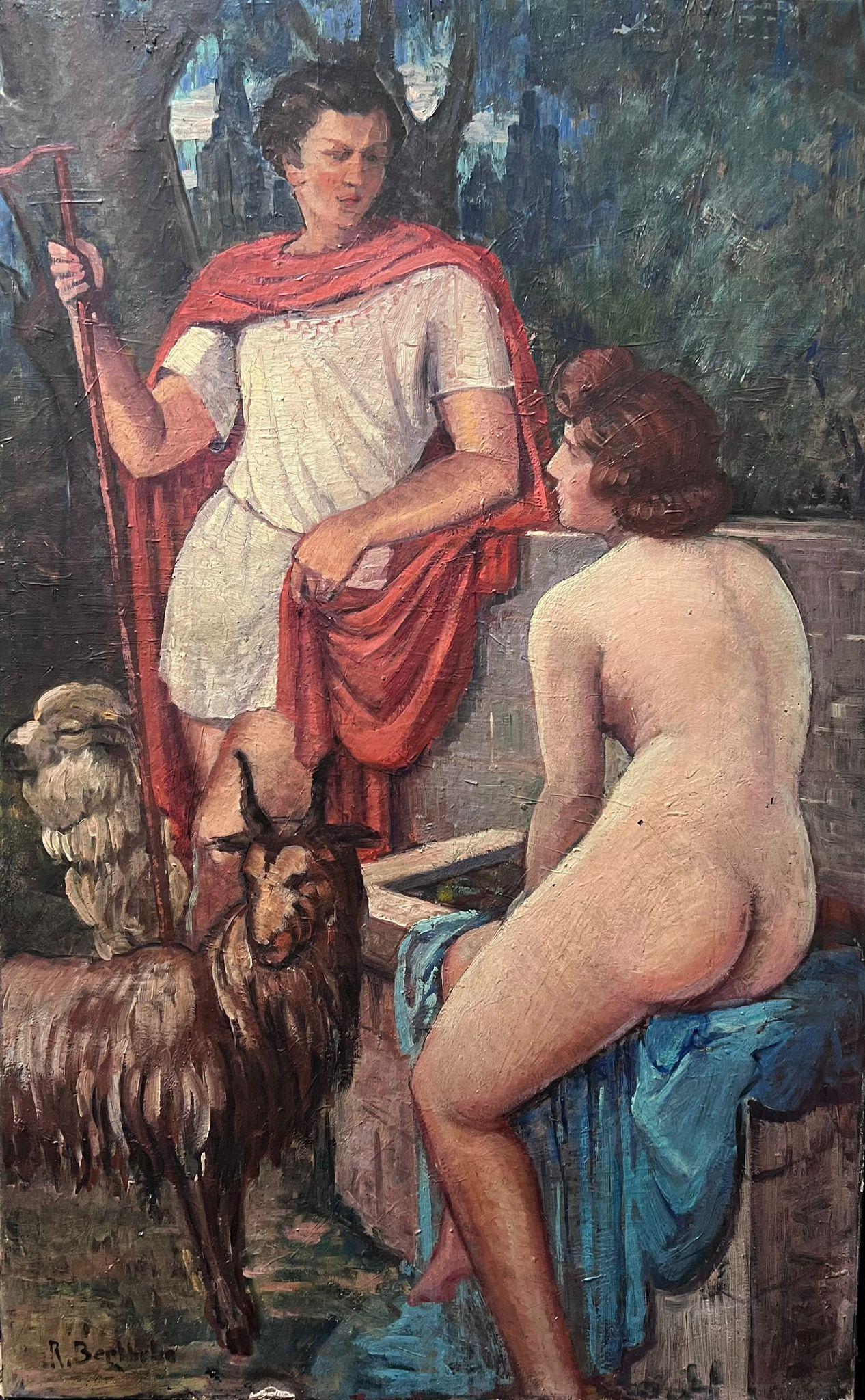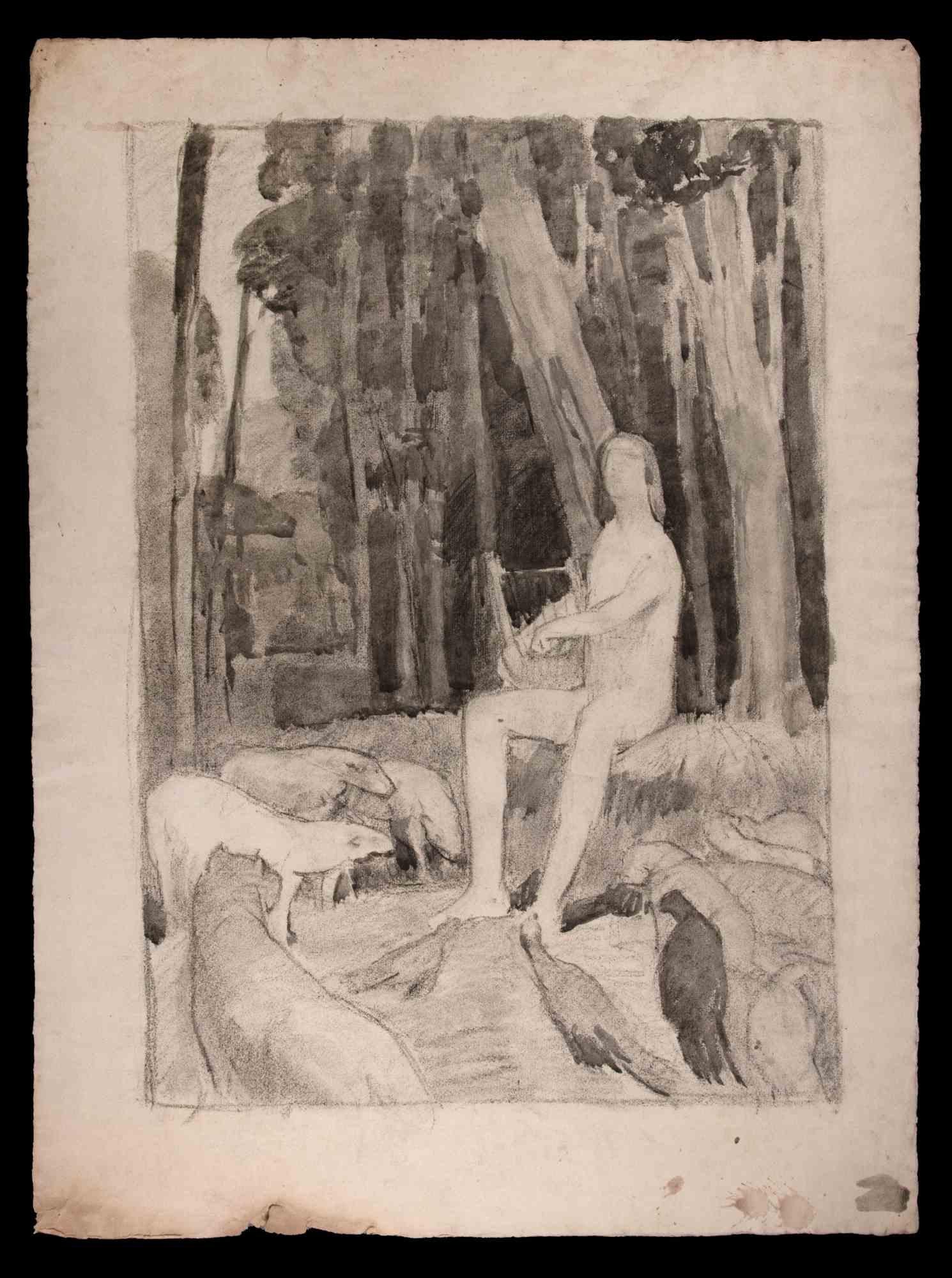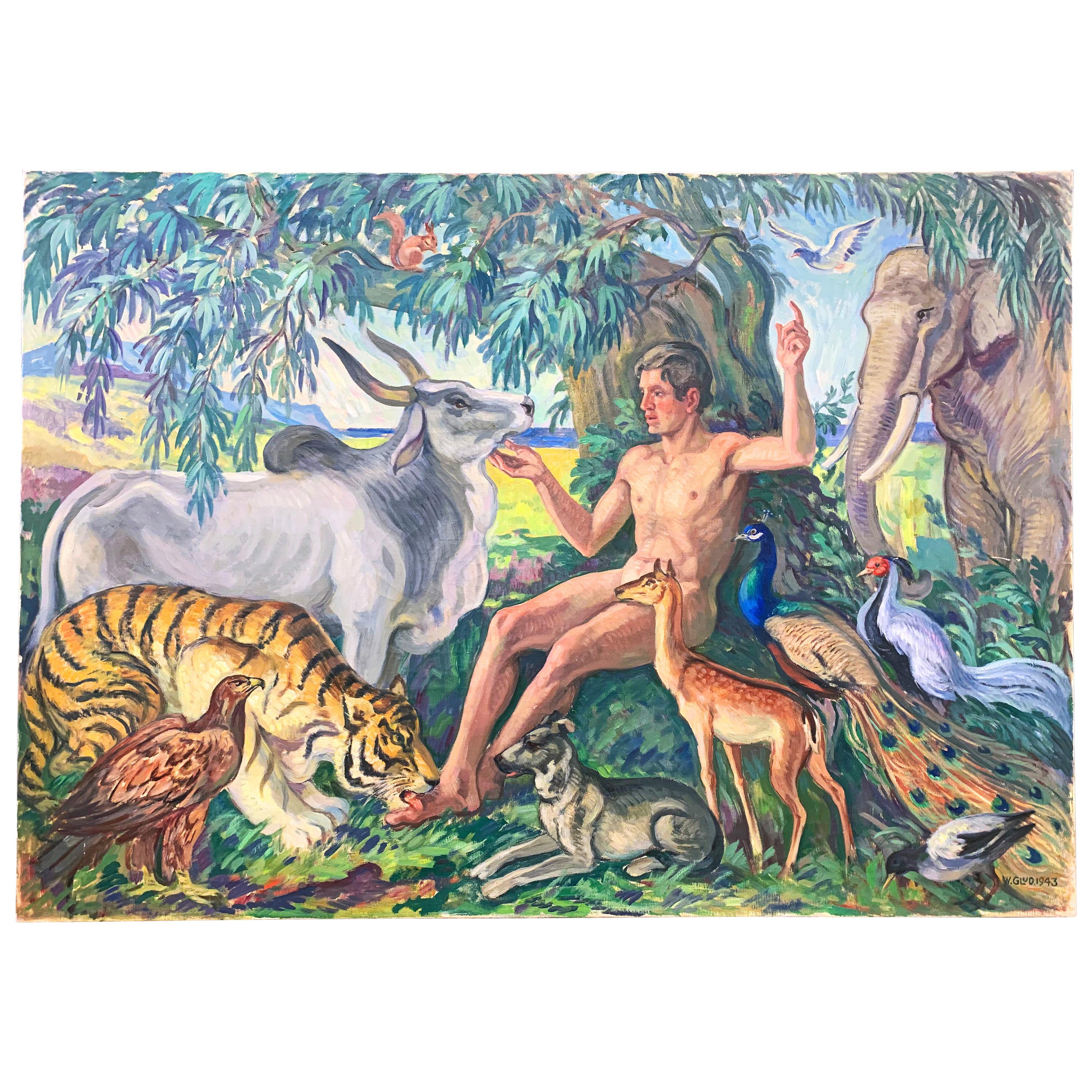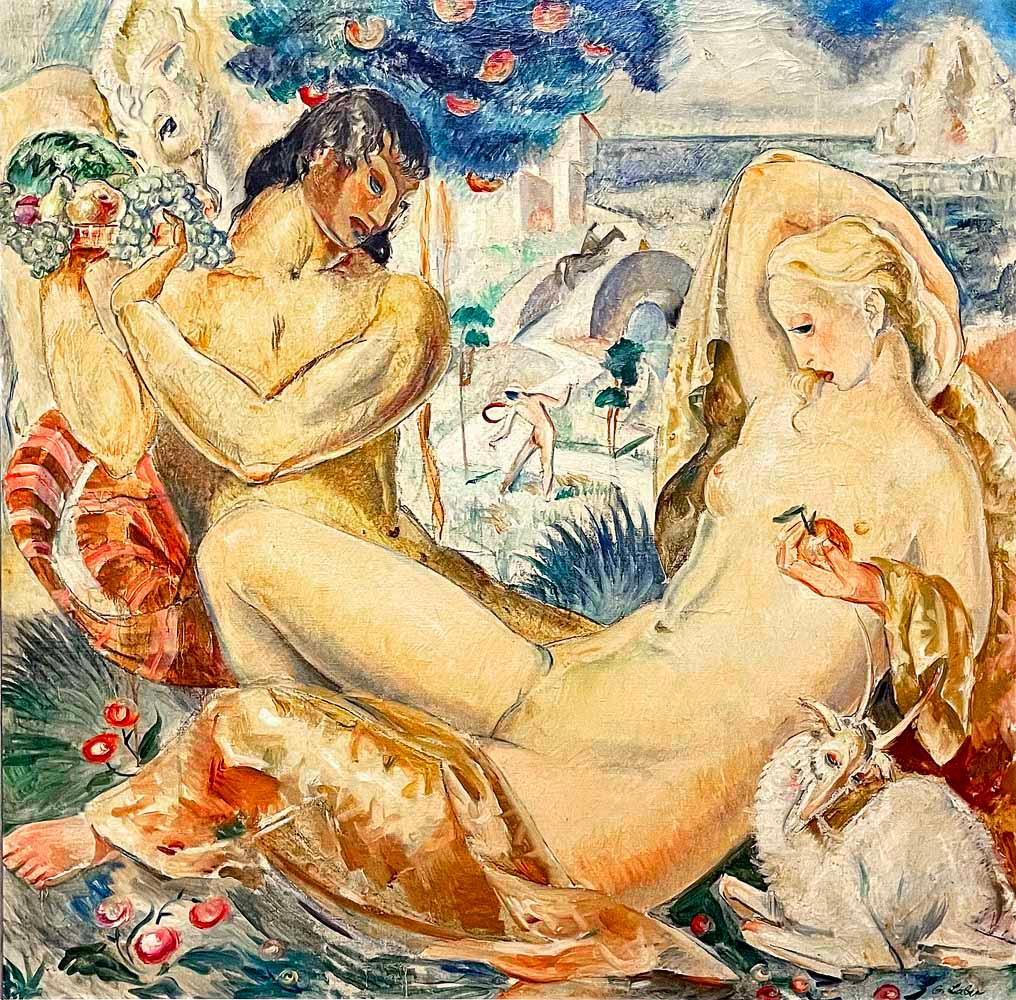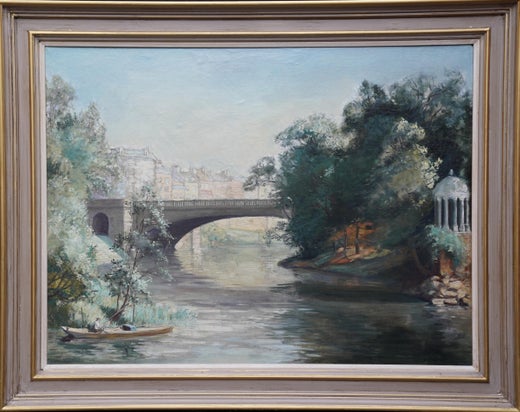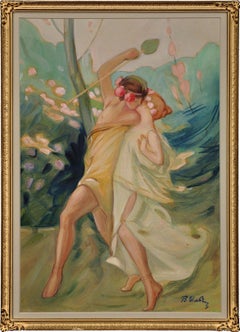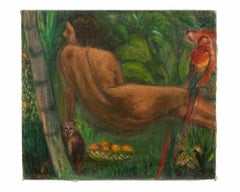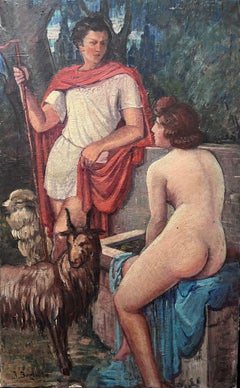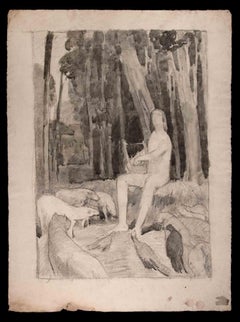Items Similar to Pan God Of Nature Playing Panpipes Mythological Nude With Animals Oil Painting
Want more images or videos?
Request additional images or videos from the seller
1 of 24
Margaret Maitland HowardPan God Of Nature Playing Panpipes Mythological Nude With Animals Oil Painting
$11,848.50
£8,695
€10,247.94
CA$16,306.92
A$18,175.76
CHF 9,536.20
MX$221,955.62
NOK 120,748.97
SEK 114,126.15
DKK 76,484.81
About the Item
Margaret Maitland Howard.
English ( b.1898 - d.1983 ).
Pan, God Of Nature, Playing Panpipes.
Oil On Canvas.
Signed Lower Left.
Image size 22.6 inches x 18.1 inches ( 57.5cm x 46cm ).
Frame size 26.8 inches x 22.2 inches ( 68cm x 56.5cm ).
Available for sale; this original oil painting is by the English artist Margaret Maitland Howard and dates from the 1930s.
The painting is presented and supplied in a sympathetic contemporary frame (which is shown in these photographs), mounted with new fixtures.
The canvas has been lined and mounted on a newly constructed custom made stretcher. The painted surface has benefitted from cleaning and conservation, all of which was performed on our instruction, supervision and approval.
This vintage painting is now in very good condition. It wants for nothing and is supplied ready to hang and display.
The painting is signed lower left.
Margaret Maitland Howard was an accomplished and versatile English artist whose works spanned the early to mid-20th century. Known for her evocative and often mythologically inspired oil paintings, Howard’s work reflects a deep engagement with classical themes and her knowledge of nature, and the human form. She was also proficient working in watercolours and pastels and an accomplished sculptor.
Margaret, who was always known as “Marjorie” was born in Friern, Barnet, London on 31 July 1898, the daughter of artist and civil servant Henry James Howard. She grew up at Sutton, Surrey, where she spent most of her life. She spent many years living and working from St. Katherine’s, Malgrave Road, Sutton, Surrey.
She was educated privately, at the Byam Shaw and then attended the Vicat Cole School of Art, completing her studies at the Royal Academy Schools, where she won five silver medals and other awards. She was also the recipient of a British Institute scholarship and extension and won the 1926 prize for her portrait work at the National Welsh Eisteddfod in Swansea.
She exhibited paintings at the Royal Academy, showing at least ten works of classical and biblical themes at Summer Exhibitions between 1923 and 1935. She was one of the early group of women who painted nudes, a practice which was considered somewhat risqué and vulgar in the early twentieth century. She also exhibited at other leading galleries and in the provinces and consistently pursued her art despite the challenges posed by the societal norms of the time.
Howard had a significant professional career for a woman of her generation. Just after World War II she was appointed draughtsman to the Institute of Archaeology at London University where she worked from 1948 to 1960. This is now part of University College, London. Here, she worked as an illustrator and sculptor, creating models for Professor Frederick Zeuner to use in his lectures. She also illustrated one of his important books (Zeuner, F.E. Dating the Past, London: Methuen). She also created the bust of Gordon Childe, now in the Institute’s Library. After her retirement from the Institute of Archaeology she collaborated with Ian Wolfran Cornwall on his series of books about the prehistoric world.
In 1956, whilst working for the British Institute for the Study of Iraq, she moved to Balawat and supervised the archaeological work at the site of an ancient Assyrian city in northern Mesopotamia. She subsequently prepared drawings of the Balawat Gates, which was significant and technical work.
In addition to illustrating various books on ancient history and anthropology, Howard was also known as an illustrator of fictional books, producing an illustrated edition of the Fables of Aesop that was published by John Lane at The Bodley Head in 1926. She also illustrated Elizabeth Ward’s Who Goes to the Wood (Lutterworth, 1940).
Howard lived a long and productive life. Her recreations included reading and riding, and she was an active member of Ridley Art Club
Margaret Maitland Howard passed away on 31 August 1983, leaving behind a body of work that continues to be admired for its beauty, technical skill, and the timeless quality of its subject matter. Today, her paintings are considered valuable pieces of classical-inspired art, appreciated by collectors and art historians for their unique contribution to 20th-century English art. Her ability to fuse mythological themes with a deep sense of nature remains a defining feature of her legacy.
© Big Sky Fine Art
This is a delightfully quirky and detailed oil on canvas painting by Margaret Maitland Howard. It depicts a pastoral scene rich in symbolism and classical themes. At the centre, a nude, androgynous figure plays a set of panpipes, evoking the image of Pan, the ancient Greek god of nature, shepherds, and rustic music. The figure is seated on a rock, surrounded by a group of attentive animals, including a bear, a weasel, and several sheep with curled horns, gazing curiously at the musician.
The background features a softly rolling landscape with a gradient of green and brown hues, giving depth to the scene and a sense of calm. The sky is painted with a gentle gradient, transitioning from a pale yellow near the horizon to a soft blue. The overall composition blends mythological and natural elements, emphasizing harmony between the human figure and the animals, all of which are intricately detailed. The signature “Maitland Howard” is clearly visible in the lower left, anchoring the work as a distinctive piece by the artist.
Pan is a prominent figure in Greek mythology, known as the god of the wild, shepherds, flocks, nature, rustic music, and often associated with fertility. He is typically depicted as having the upper body of a man with the legs and horns of a goat, embodying the untamed aspects of the natural world. Pan is closely linked to the countryside and pastoral life, often roaming through forests and fields, playing his signature musical instrument—the panpipes, or syrinx.
The panpipes, or syrinx, is a musical instrument made up of multiple tubes of varying lengths, typically made from reeds, wood, or bamboo. Each tube produces a different pitch when blown into, and together they create a haunting and melodious sound.
The instrument’s name comes from a myth involving Pan and a nymph named Syrinx. According to the story, Syrinx was a beautiful nymph who caught Pan’s eye, but she did not return his affections. As Pan pursued her, she fled and prayed to the river gods to save her. In response, they transformed her into a bundle of reeds. Heartbroken, Pan found the reeds and noticed that when the wind blew through them, they produced a melodious sound. He cut the reeds and fashioned them into a set of pipes, which he named the syrinx in her memory.
The panpipes symbolize Pan’s connection to nature and his role as a pastoral deity. The instrument’s music is often associated with the enchanting, yet wild and unpredictable, sounds of the natural world. In art and literature, Pan playing the panpipes often evokes themes of nature’s harmony, the beauty of the rural landscape, and sometimes the more untamed, primal aspects of life.
Pan’s association with the panpipes also underscores his dual nature as both a benevolent, musical figure and a god who embodies the wild, instinctual side of existence. This duality makes Pan a complex and intriguing figure in mythology, representing the balance between civilization and the natural world.
- Creator:Margaret Maitland Howard (1898 - 1983, British)
- Dimensions:Height: 26.78 in (68 cm)Width: 22.25 in (56.5 cm)Depth: 1.28 in (3.25 cm)
- Medium:
- Movement & Style:
- Period:
- Condition:The canvas has been lined and mounted on a newly constructed custom made stretcher. The painted surface has benefitted from cleaning and conservation, all of which was performed on our instruction, supervision and approval.
- Gallery Location:Sutton Poyntz, GB
- Reference Number:1stDibs: LU489314992952
Margaret Maitland Howard
Margaret (Marjorie) Maitland Howard was a painter, illustrator and draughtswoman. Born in London, she studied at the Byam Shaw School of Art and the Royal Academy School of Art, where she was a multiple silver medal-winner. She exhibited at the Royal Academy, New English Art Club (NEAC) and the Society of Women Artists (SWA), amongst others. Though a 20th century artist, her best work has a romantic neoclassical style, reminiscent of the Pre-Raphaelites and late Victorian classicists.
About the Seller
5.0
Vetted Professional Seller
Every seller passes strict standards for authenticity and reliability
Established in 2010
1stDibs seller since 2016
122 sales on 1stDibs
Typical response time: 1 hour
- ShippingRetrieving quote...Shipping from: Sutton Poyntz, United Kingdom
- Return Policy
Authenticity Guarantee
In the unlikely event there’s an issue with an item’s authenticity, contact us within 1 year for a full refund. DetailsMoney-Back Guarantee
If your item is not as described, is damaged in transit, or does not arrive, contact us within 7 days for a full refund. Details24-Hour Cancellation
You have a 24-hour grace period in which to reconsider your purchase, with no questions asked.Vetted Professional Sellers
Our world-class sellers must adhere to strict standards for service and quality, maintaining the integrity of our listings.Price-Match Guarantee
If you find that a seller listed the same item for a lower price elsewhere, we’ll match it.Trusted Global Delivery
Our best-in-class carrier network provides specialized shipping options worldwide, including custom delivery.More From This Seller
View AllFramed Art Nouveau Period Painting A Greek Love Affair Theseus And Ariadne
By Antoine Calbet
Located in Sutton Poyntz, Dorset
Follower of Antoine Calbet.
French ( b.1860 - d.1944 ).
Theseus and Ariadne, Circa 1890 - 1910.
Mixed Media.
Watercolour, Gouache & Pastel
Image size 16.5 inches x 11.2 inches ( 42cm...
Category
Early 1900s Art Nouveau Figurative Paintings
Materials
Paper, Pastel, Watercolor, Gouache
A Liberated Lady On The Cliffs Nude Sunbathing Framed 1920s French Oil Painting
Located in Sutton Poyntz, Dorset
Raymond Moritz.
French ( b.1891 - d.1950 ).
A Liberated Lady On The Cliffs, 1927.
Oil On Canvas.
Signed Lower Left.
Image size 25 inches x 20.7 inches ( 63.5cm x 52.5cm ).
Frame size 29.3 inches x 24.8 inches ( 74.5cm x 63cm ).
Available for sale; this original oil painting is by the French artist Raymond Moritz and dates from 1927.
The painting is presented and supplied in a sympathetic contemporary frame (which is shown in these photographs), mounted with new fixtures.
The canvas and the painted surface have benefitted from cleaning and conservation, which was performed on our instruction, supervision and approval.
This vintage painting is now in very good condition. It wants for nothing and is supplied ready to hang and display.
The painting is signed lower left.
A later dedication to “Louise” dated April 1942 in the artist’s hand is set around the earlier signing.
Raymond Moritz was a French impressionist artist and illustrator. He was born in Paris on 8 July 1891. His family came from the Alsace region and were poor and Catholic. On his mother’s side, the Staubs were from Wihr-au-Val where they had been coopers for several generations. His uncle, Marie Clement Staub, was the founder in Canada of the Sisters of Saint Joan of Arc.
Moritz fought during the Great War in the Picardy region of the Somme with the 2nd machine gunner company. He won the French 1914-1918 War medal with bronze palm attachment, which signifies that the awardee was mentioned in dispatches at army level. Moritz obviously created some art during the war because during the inauguration of the new town hall in the town of Albert he was congratulated by the French President, Albert Lebrun, and the British press for the paintings he had produced. Albert was the main town behind the lines for the Allies on the Somme battle fields...
Category
Early 20th Century Art Deco Nude Paintings
Materials
Oil, Canvas
Framed 1860s French Academic Style Oil Painting Romantic & Mythological Themes
By André Charles Voillemot
Located in Sutton Poyntz, Dorset
André Charles Voillemot.
French ( b.1822 - d.1893 ).
Allegory Of Summer.
Oil On Canvas.
Signed Lower Left.
Dedication Lower Left To Victorien Sardou (1831 – 1908).
Image size 18.1 in...
Category
Mid-19th Century Academic Nude Paintings
Materials
Canvas, Oil
La Muse Framed 1937 French Post-Impressionist Oil Painting Of A Female Nude
By Henri Vincent-Anglade
Located in Sutton Poyntz, Dorset
Henri Vincent-Anglade.
French ( b.1876 - d.1956 ).
La Muse, 1937.
Oil On Canvas.
Signed & Dated 1937 Upper Right.
Image size 31.3 inches x 20.7 inches ( 79.5cm x 52.5cm ).
Frame size...
Category
Mid-20th Century Post-Impressionist Nude Paintings
Materials
Canvas, Oil
Art Nouveau Watercolor Painting Naked Lady Red Boa Skating Pulled By A Poodle
Located in Sutton Poyntz, Dorset
Oscar Wilson.
English ( b.1867 - d.1930 ).
The Lady Of The Lake.
Watercolor & Ink On Paper.
Signed Lower Left.
Image size 17 inches x 10.2 inches ( 43cm x 26cm ).
Frame size 23 inc...
Category
Early 20th Century Art Nouveau Figurative Drawings and Watercolors
Materials
Ink, Watercolor, Paper
Cloaked Shepherdess Pre-Raphaelite Arts & Crafts Aesthetics Original Watercolor
By Philip Richard Morris
Located in Sutton Poyntz, Dorset
Philip Richard Morris.
English ( b.1836 - d.1902 ).
The Cloaked Shepherdess.
Watercolor.
Signed Lower Left.
Image size 14 inches x 9.3 inches ( 35.5cm x 23.5cm ).
Frame size 26.3 in...
Category
Late 19th Century Romantic Figurative Drawings and Watercolors
Materials
Watercolor
You May Also Like
Óleo sobre tela - Fauno tocando la flauta y ninfas en un bosque
Located in Sant Celoni, ES
La obra va firmada por el artista en la parte inferior y fechada del año 1922
Se presenta sin enmarcar la pintura
El estado de la obra es bueno
Medidas obra: 94 x 74 cm.
::::::::...
Category
1920s Impressionist Figurative Paintings
Materials
Oil
Nude with Tropical Animals - Oil Painting on Canvas by A. Feltrinelli - 1920s
Located in Roma, IT
Nude with Tropical Animals is a beautiful and impressive oil on canvas by Antonio Feltrinelli.
It was realized between the end of the 1920s and the b...
Category
Early 20th Century Modern Figurative Paintings
Materials
Oil
Huge 1900's Italian Impressionist Signed Oil Painting Shepherd Talking to Nude
Located in Cirencester, Gloucestershire
Shepherd with Flock and Nude Lady by Fountain
Italian School, circa 1900's
indistinctly signed, 'R. Bertholio'?
signed oil on canvas, unframed
canv...
Category
Early 20th Century Impressionist Figurative Paintings
Materials
Oil, Canvas
Young Shepherd plays the Lyre - Original Drawing - Early 20th Century
Located in Roma, IT
Young Shepherd plays the Lyre is an original drawing on paper. Is not signed and dated but we can attribute the period early 20th Century.
The artis...
Category
Mid-20th Century Modern Figurative Drawings and Watercolors
Materials
Paper
"Adam in Eden, " Monumental Depiction of Paradise in Wartime
By Wilfred Peter Glud
Located in Philadelphia, PA
A remarkable statement of hope and resilience, this vivid and colorful depiction of a nude Adam seated amidst a profusion of flora and fauna was painted in the midst of World War II ...
Category
Vintage 1940s Danish Art Deco Paintings
Materials
Paint
$15,600 Sale Price
20% Off
"Satyr and Nymph", Art Deco Masterpiece Painting with Nudes in Paradise, 1932
Located in Philadelphia, PA
One of the most sensual and brilliant Art Deco paintings in the French manner that we have ever offered, this idyllic scene of Satyr and Nymph, lounging under a fruited tree with lush fields in the distance, was painted by Gheorghe Labin in 1932. Labin was one of Romania's avant-garde artists in the 1920s and 1930s, and clearly he trained in Paris, because the lush scene, brilliant palette, and confident brush strokes indicate an intimate familiarity with the leading painters associated with what we now call Art Deco. This painting was entered into the Salon Bucarest in 1932, in a period when Labin exhibited with Mattis Teutsch, the de facto leader of Romania's modern painters, together with Corneliu Baba...
Category
Vintage 1930s Romanian Art Deco Paintings
Materials
Paint
More Ways To Browse
Animal Head
God Painting
Animal Legs
Romantic Vintage Paintings
Wood Animal Mid Century
Vintage Nature Photograph
Man Reading Painting
Oil Painting Mythological
Ancient Classical Paintings
Wood Animal Heads
Quirky Painting
Greek Mythology Painting
Painting By Cole
Civil War Oil Painting
Painting Musical Instruments
Paintings With Musical Instruments
Bamboo Framed Painting
Surrey Oil Painting
